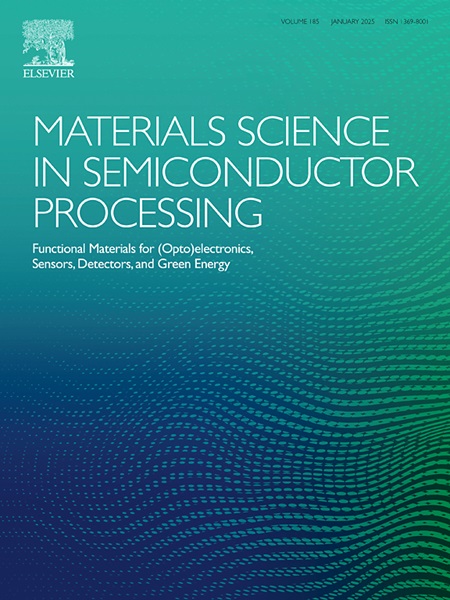利用液态浸入式线切割放电加工技术加工氧化镓晶体
IF 4.2
3区 工程技术
Q2 ENGINEERING, ELECTRICAL & ELECTRONIC
引用次数: 0
摘要
为了解决传统机械加工氧化镓(Ga2O3)晶体过程中常见的开裂和劈裂问题,本研究提出了一种液态浸入式线切割放电加工(WEDM)技术。该研究还发现,Ga2O3 晶体生长过程中的偏析现象会导致晶体内部电阻率不均匀,从而导致传统的喷射式放电线切割技术失效。为了克服这一局限性,研究人员提出了液体浸入式线切割技术的可行性,并建立了实验平台。在煤油浸泡下对 Ga2O3 切割表面进行的电阻率测量显示,电阻率差值减少了约 99.2%。这一结果表明,在加工过程中形成的碳膜可以有效补偿固有的非均匀电阻率。为煤油中 Ga2O3 晶体的液浸 WEDM 建立了等效电路模型。对煤油中碳氢化合物在放电温度下的分解反应进行了热力学和动力学分析。结果证实,在放电过程中可能会发生分解反应。对 Ga2O3 硅锭进行了截断实验,并提出了在加工 1 英寸硅片时使用单晶硅进行电辅助的方法。实验结果表明,在煤油中对 Ga2O3 晶体进行液浸线切割能有效抑制开裂和劈裂,加工精度在 50 μm 以内,并成功生产出 1 英寸圆形 Ga2O3 硅片,加工精度比金刚石线切割提高了约 66.6%。本文章由计算机程序翻译,如有差异,请以英文原文为准。
Processing of gallium oxide crystals using liquid-immersion wire-cut electrical discharge machining
To address the issues of cracking and cleavage commonly encountered during conventional mechanical processing of gallium oxide () crystals using several methods, such as outer circle cutting and diamond wire sawing, this study proposed a liquid-immersion wire-cut electrical discharge machining (WEDM) technique. This study also revealed that the segregation phenomena during the growth of crystals resulted in non-uniform resistivity within the crystal, leading to the failure of traditional spray-type electro-discharge wire-cutting techniques. To overcome this limitation, the feasibility of the liquid-immersion WEDM technique was proposed, and an experimental platform was established. Resistivity measurements of the cut surfaces of in kerosene immersion revealed a reduction of approximately 99.2 % in the resistivity difference. This result shows that the formation of carbon films during processing can effectively compensate for the intrinsic non-uniform resistivity. An equivalent circuit model for liquid-immersion WEDM of crystals in kerosene was developed. Thermodynamic and kinetic analyses were conducted on hydrocarbon decomposition reactions in kerosene at discharge temperatures. The results confirmed that decomposition reactions could occur during the discharge process. A truncation experiment for ingots was conducted, and a method using single-crystal silicon for electrical assistance in the processing of 1-inch wafers was proposed. The experimental results showed that liquid-immersion WEDM of crystals in kerosene effectively suppressed cracking and cleavage, achieving a processing accuracy within 50 μm and successfully producing a 1-inch circular wafer, with the machining accuracy improved by approximately 66.6 % compared to diamond wire cutting.
求助全文
通过发布文献求助,成功后即可免费获取论文全文。
去求助
来源期刊

Materials Science in Semiconductor Processing
工程技术-材料科学:综合
CiteScore
8.00
自引率
4.90%
发文量
780
审稿时长
42 days
期刊介绍:
Materials Science in Semiconductor Processing provides a unique forum for the discussion of novel processing, applications and theoretical studies of functional materials and devices for (opto)electronics, sensors, detectors, biotechnology and green energy.
Each issue will aim to provide a snapshot of current insights, new achievements, breakthroughs and future trends in such diverse fields as microelectronics, energy conversion and storage, communications, biotechnology, (photo)catalysis, nano- and thin-film technology, hybrid and composite materials, chemical processing, vapor-phase deposition, device fabrication, and modelling, which are the backbone of advanced semiconductor processing and applications.
Coverage will include: advanced lithography for submicron devices; etching and related topics; ion implantation; damage evolution and related issues; plasma and thermal CVD; rapid thermal processing; advanced metallization and interconnect schemes; thin dielectric layers, oxidation; sol-gel processing; chemical bath and (electro)chemical deposition; compound semiconductor processing; new non-oxide materials and their applications; (macro)molecular and hybrid materials; molecular dynamics, ab-initio methods, Monte Carlo, etc.; new materials and processes for discrete and integrated circuits; magnetic materials and spintronics; heterostructures and quantum devices; engineering of the electrical and optical properties of semiconductors; crystal growth mechanisms; reliability, defect density, intrinsic impurities and defects.
 求助内容:
求助内容: 应助结果提醒方式:
应助结果提醒方式:


